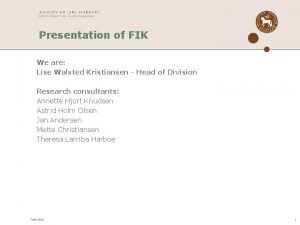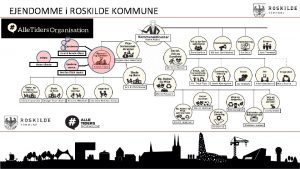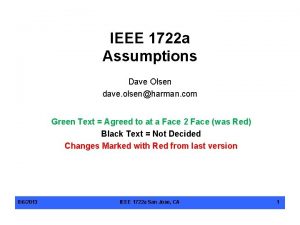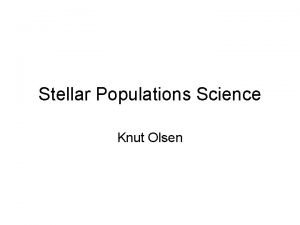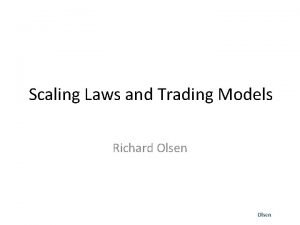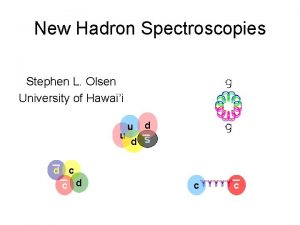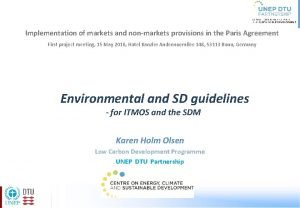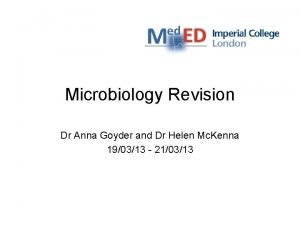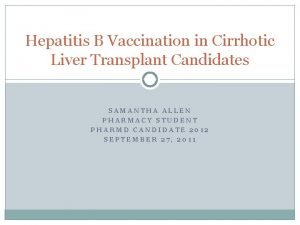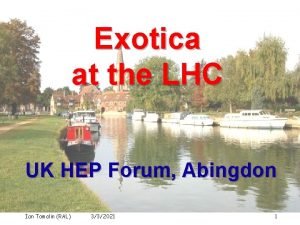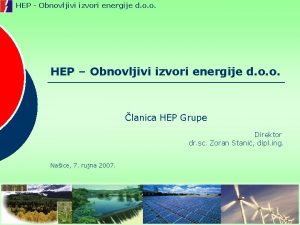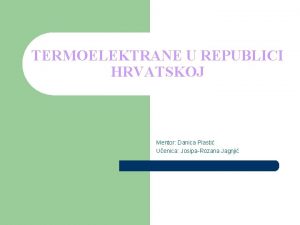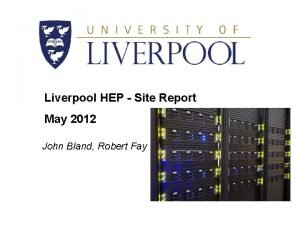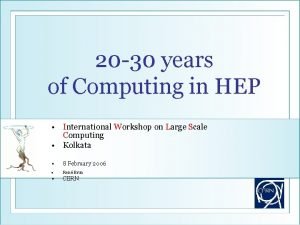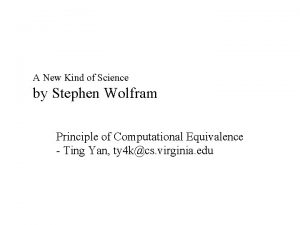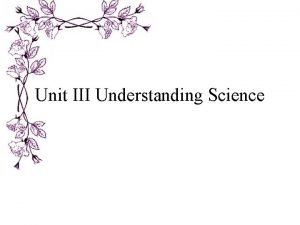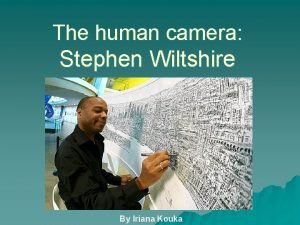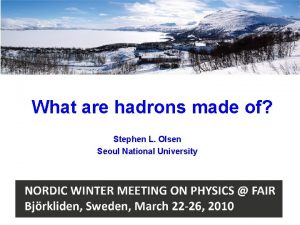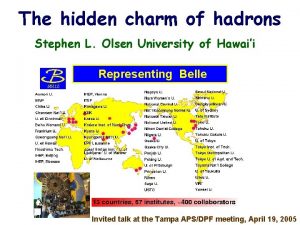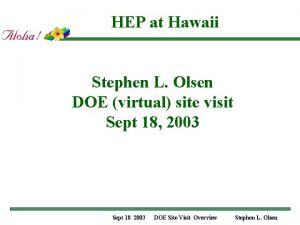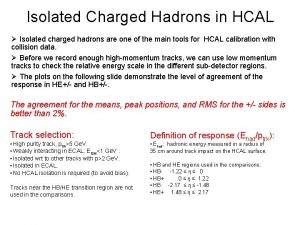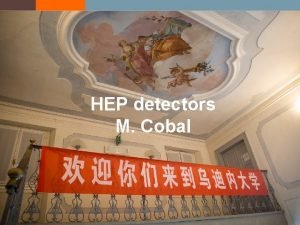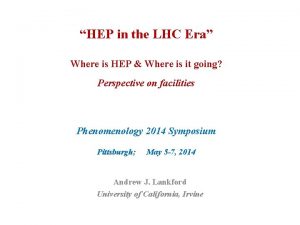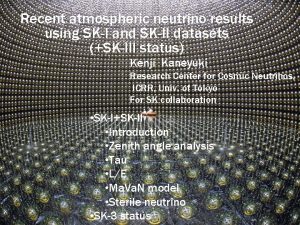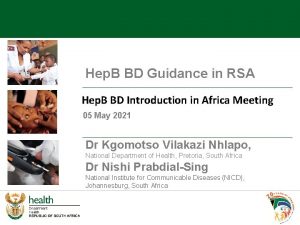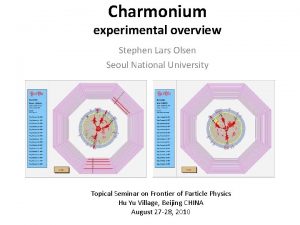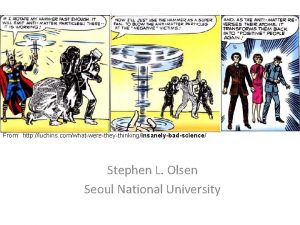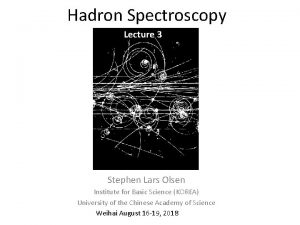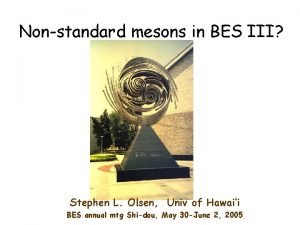Stephen Olsen New types of hadrons HEP 10

























































- Slides: 57

Stephen Olsen 夏威夷 大学 & 新强子� New types of hadrons HEP 10 南京大学 April 26, 2008 高能所 北京

Constituent Quark Model (CQM) Gell-Mann (& 6 antiquarks) 6 quarks u+2/3 c+2/3 t+2/3 d-1/3 s-1/3 b-1/3 Baryons: qqq p: p: u+2/3 d-1/3 u-2/3 U-2/3 D+1/3 u-2/3 c-2/3 d+1/3 t-2/3 +1/3 s+1/3 b Mesons: q q p+ : p- : u+2/3 d+1//3 u-2/3 d-1/3 Zweig

Fabulously successful mesons q q

QCD suggests non-qq meson spectroscopies glueball

Charmonium model predictions for cc mesons are robust & reliable, both for masses & transition rates. Therefore, it is an especially good system to use to search for non-qq mesons.

predicted measured

About 20 measured transition rates D 1 D D( *) Ds. Ds DD g p 0 pp, h, p 0 g g pp DD g measured rates all agree with predictions (more-or-less)

About 20 measured transition rates D 1 D D( *) Ds. Ds DD g p 0 pp, h, p 0 g g g pp • • • DD G(pp-allowed) 50~ 100 ke. V G(p – ispin viol)~0. 5 ke. V G(E 1 -gamma) 20~200 ke. V G(M 1 -gamma)~1 ke. V G(D(*)) ≥ 10 Me. V

I’ll emphasize recent results.

X(3872) pp X + p+p-J/y B± K±p+p-J/y ’ ’ ’ X(3872)

M(pp) looks like r pp CDF Belle c 2/dof = 43/39 (CL=28%) PRL 96 102002 kinematic limit≈mr • Belle & CDF: JPC = 1++ most likely = 2 -+ still possible

X(3872) properties (PDG 2007) Me. V MD 0 + MD*0 = 3871. 8 ± 0. 4 Me. V

What is it? • L Maiani et al PRD 71, 014028 (2005) c c cc 1’ charmonium? • T-W Chiu & TH Hsieh • C Meng & KT Chao PRD 75, 114002 (2007) PRD 73, 111503 (2006) • D Ebert et al … PLB 634, 214 (2006) • NA Tornqvist PLB 590, 209 (2004) • ES Swanson PLB 598, 197 (2004) • E Braaten & T Kusunoki PRD 69 074005 (2004) • CY Wong PRC 69, 055202 (2004) • MB Voloshin PLB 579, 316 (2004) • F Close & P Page … PLB 578, 119 (2004) too light? ? P Lacock et al (UKQCD) PLB 401, 308 (1997)

Is X(3872) a Charmonium state? 3872 Me. V ? ?

Could the X(3872) be the cc 1’ (23 P 1)? ? ? 3872 Me. V • Mass is too low • cc 1’ pp. J/y violates Ispin • G(g. J/y) should be >>G{r. J/y) • expt: G(g. J/y) <<G(r. J/y)

Could the X(3872) be the hc 2 (11 D 2)? 3872 Me. V ? ? • hc 2’ pp. J/y violates Ispin • G(g. J/y) should be very small • expt: G(g. J/y) 0. 1 G(r. J/y) • B Khc 2 should be very small

Is X(3872) a diquark-diantiquark? Where are the “partner states”? Xu(3872) u c c u B+ K-Xu Xd(3872) X+(3872) u c c d d c c d X-(3872) d c c u Ba. Bar: B 0 K 0 Xd M(Xd)-M(Xu)= 2(md-mu)/cosq 8 ± 3 Me. V L Maiani et al PRD 71, 014028 (20050 Bf(B 0 K-X+)Bf(X+ p+p 0 J/y) Bf(B- K-X 0)Bf(X+ p+p-J/y) < 0. 4 (expected value is 2) PRD 71, 031501 (2005)

B KSX & B K±X comparison Ba. Bar 0803. 2838 K± mode KS mode DM = 0. 22 ± 0. 90 ± 0. 27 Me. V Compared to 8± 3 Me. V DM = 2. 7 ± 1. 6 ± 0. 4 Me. V (Maiani et al PRD 71 014028)

0 0 X(3872) D D* ? Ba. Bar & Belle see a DD* threshold enhancement in B KDD* G. Gokhroo et al. (Belle) D 0 p 0 B. Aubert et al. (Ba. Bar) Phys. Rev. D 77, 011102 (2008) Both groups see a high mass value & a Bf(DD*) 10 x Bf(p+p-J/y) “DD* molecular” models Predicted Bf(DDp) 0. 1 Bf(p+p-J/y) (c. f. E. S. Swanson PLB 588, 189 (2004))

ar. Xiv: 0801. 3540 ” ”…

Still (5 yrs after discovery) no universally accepted explanation for the X(3872). (Although some kind of DD* molecular state --either real or virtual-- seems most popular. )

The -1 states seen in ISR

+ e e gisr Y(4260) at Ba. Bar PRL 95, 142001 (2005) fitted values: M=4259 8 G = 88 23 233 fb-1 Y(4260) +2 -6 +6 -9 Me. V

Not seen in e+e- hadrons J. Z. Bai et al (BES), PRL 88, 101802 (2006) (e+e- hadrons) (e+e- m+m-) m 4260 G(Y 4260 p+p- J/y) niu o m ar s h BES data y c dard b ge stan u h > 1. 6 Me. V @ 90% CL X. H. Mo et al, PL B 640, 182 (2006)

“Y(4260)” at Belle M=4247 12 +17 -32 Me. V G = 108 19 ± 10 Me. V M=4008 40 +114 -28 (New) Ba. Bar values: M=4259 8 G = 88 23 +2 -6 +6 -9 Me. V G = 226 44 ± 87 Me. V ? ? ? Resonance? Thresh effect? …? C. Z Yuan et al (Belle) ar. Xiv: 0707. 2541 PRL 99, 182004

No 1 -- cc slot for the Y(4260) X. H. Mo et al, hep-ex/0603024 4260

! Is the Y(4260) a cc-gluon hybrid? ! ! e s e c c th f o l • qq-gluon excitations predicted 30 yrs ago l a h c • lowest 1 cc-gluon mass expected at ~4. 3 Ge. V t a m o • relevant open charm tthreshold is D**D (~4. 28 Ge. V) s m e than that for normal charmonium • G(pp. J/y) larger e s ) 0 • G(e e )6 smaller than that for ordinary charmonium 2 4 ( Y Horn & Mandula PRD 17, 898 (1977) -- Banner et al, PRD 56, 7039 (1997); Mei & Luo, IJMPA 18, 15713 (2003) Isgur, Koloski & Paton PRL 54, 869 (1985) Mc. Neile, Michael & Pennanen PRD 65, 094505 (2002) + - Close & Page NP B 443, 233 (1995)

D** spectrum D 1 D D 2 D DD** thresholds in & “Y(4260)” No obvious distortions 4. 28 -m. D M(p+p-J/y) Ge. V

D 1 D D D 2 Ba. Bar’s p+p-y’ peak at 4325 Me. V e+e- g. ISR p+p- y’ 298 fb-1 (Ba. Bar) hep-ex/0610057 Nevt = 68 (<5. 7 Ge. V/c 2) Nbkg = 3. 1 1. 0 M=4324 24 Me. V G = 172 33 Me. V above all D**D thresholds Not Compatible with the Y(4260) Ba. Bar PRL 98 252001 (2007) S. W. Ye QWG-2006 June 2006 2 -prob Y(4260) (4415) < 5. 7 Ge. V/c 2 6. 5 10 -3 1. 2 10 -13 Y(4320) 29%

4325 Me. V p+p-y’ peak in Belle Two peaks! M=4361 9 ± 9 Me. V 4260 G = 74 15 ± 10 Me. V 548 fb-1 (new) (both relatively narrow) (& both above D**D thresh) (& neither consistent with 4260) M=4664 11 ± 5 Me. V G = 48 15 ± 3 Me. V X. L. Wang et al (Belle) ar. Xiv: 0707. 3699 PRL 99, 142002 (2007) Ba. Bar values M=4324 24 Me. V G = 172 33 Me. V

Y(4360) & Y(4660) are above all D**D thresholds D** spectrum 4. 66 -m. D 4. 36 -m. D

No sign of Y(4360) or Y(4660) in e+e- D(*) or DDp 4360 4660 DD+DD*+D*D*+DDp Pakhlova (Belle) PRL 98, 092001 (2007)

The Y(4260) looks like a hybrid But the Y(4360) and Y(4660) -which look like the Y(4260)do not look like hybrids.

Recent News lly a ric ed!! t ec arg l e h c

± M(p y’) K* Kp Veto from B K KVeto 2* Kp? ± p y’ M = 4433 ± 4 ± 1 Me. V Gtot = 45 +17 +30 -13 -11 Me. V M 2(py’) Ge. V 2 Nsig =124 ± 31 evts 6. 5 M 2(Kp) Ge. V 2 M(py’) Ge. V S. -K. Choi et al (Belle) ar. Xiv: 0708. 1790 PRL 100 2 weeks ago

Comments on the Z+(4430) Not a reflection from the ~ Kp system (see backup slides) No significant signal in B Kp. J/y It has non-zero charge not cc or hybrid c c charmonium Mass, width & decay pattern similar to Y(4360) & Y(4660)

comments • • – – – • There seems to be a new hadron spectroscopy in the M=3. 5~5 Ge. V region Maybe more than one Bodes well for BESIII, Super-B factories & PANDA Some states are narrow even though they are far above decay thresholds e. g. Y(4660) ppy’ & Z+(4430) p+ y’ have large Q but G≈50 Me. V characterized by large partial widths (Bfs) to hadrons+J/y (or y’) – – – • Br(X(3872) r. J/y) > 4. 3% (Isospin=1) G(Y(4260) p+p-J/y) > 1. 6 Me. V G(Z(4430) py’) > 1 Me. V States that decay to y’ not seen decaying to J/y (and vice-versa) – – – Bf(Y(4660) ppy’) >> Bf(y(4660) pp. J/y) same for Y(4360) Z(4430) py’ seen but p. J/y not reported Y(4260) not seen in Y(4260) ppy’ • The new 1 -- states are not apparent in e+e- D(*) cross sections • There are no evident changes at the D**D mass threshold

New 1 -- states p+p- J/y p+p- y’ K+K- J/y C. -Z. Yuan et al (Belle) PRD 77, 011105® (2008)

DD thresholds DSDS thresholds some of the states are near thresholds, but this is not a universal feature

Are there XYZ counterparts in the ss- & bb- systems?

Belle: G( (5 S) pp (n. S)) is Huge!!! (4 S) (1 S) p+p- data ossse & ction ) 8 tim es as many event s! 44± 8 evts “ (5 S)” pp (1 S) 23. 6 fb-1 from Belle 2 S 3 S 4 S Belle 0710. 2577 K. F. Chen et al (Belle) PRL 100, 112001 (2008) (4 weeks ago) 325± 20 evts! (1/20 (4 S) pp (1 S) times ~ 1 / 477 fb-1 from Belle 10 th the ctrhe

Partial Widths Assume “ (5 S)” = (5 S) N. B. Resonance cross section 0. 302 ± 0. 015 nb at 10. 87 Ge. V PRD 98, 052001 (2007) [Belle] PDG value taken for (n. S) properties >100 times bigger!! Cf (2 S) (1 S) p+p- ~ 6 ke. V (3 S) 0. 9 ke. V (4 S) 1. 8 ke. V

It looks like there is a bb version of the Y(4260) lurking around the (5 S) W. -S. Hou PRD 74, 017504 (2007) If there are bb versions of the XYZ’s, why not ss versions as well?

-1 Ys states around 2 Ge. V? Y(2175) f 0(980)f from Ba. Bar confirmed by BESII in J/y h f f 0(980) e+e- g f 0(980)h @ Ecm ~10. 6 Ge. V M(f 0(980)f Ge. V M. Ablikim et al (BES) PRL 100, 102003 (2008) 6 weeks ago

Maybe the X(1835) is one too? J/y g. X(1835) | p+p-h’ s s tly s mo X(1835) M. Ablikim et al (BESII), Phys. Rev. Lett. 95: 262001, 2005

Luciano Maiani @ had-2007

Now it looks like there may also be XYZ-like spectroscopies for the s- & b-quark sectors Implications for BES-III: • J/y (y’) running: systematic study of states decaying to f & h’ • Higher energies: look for states decaying to lower charmonia (hc, J/y, cc 1 etc. ) • …

zz le ? Lots of pieces pu 0) 3 4 (4 e Z Y(3940) ) sa m 0 4 9 3 Ar e th Y(4360) ey Y(4260) ) 0 16 50) 4 ( X Y(40 al lf ro m Y(4660) th e X( X(3872)


Backup Slides


B-factories produce lots of cc pairs 0 -+, 1 - - or 1++ 0 -+, 0++, 2++ 1 - - only C =+ states

Could Z(4430) be a reflection from the Kp channel?

Cos qp vs M 2(py’) qp p y’ K +1. 0 22 Ge. V 2 (4. 43)2 Ge. V 2 0. 25 cosqp M 2(py’) 16 Ge. V 2 M (py’) & cosqp are tightly correlated; a peak in cosqp peak in M(py’) -1. 0

Can interference between Kp partial waves produce a peak? Only S-, P- and D-waves seen in data interfere Add incoherently

Can we make a peak at cosqp≈0. 25 with only S-, P- & D-waves? Not without introducing other, even more dramatic features at other cosqp (&, , other Mpy’) values.

Y(3940) X(3940) Y(4260) X(4160) Z(4430) Y(4660) Y(4325) Y(4008) X(3872) Talk outline
 Lhc tantalizing new physics
Lhc tantalizing new physics Athena olsen
Athena olsen Lindsay olsen singer
Lindsay olsen singer Annette hjort olsen
Annette hjort olsen Uthsc olsen
Uthsc olsen Tagudskiftning roskilde
Tagudskiftning roskilde Olsen scale forex
Olsen scale forex Marie bendix olsen
Marie bendix olsen Tava olsen
Tava olsen Olsen assumption
Olsen assumption Riley olsen
Riley olsen Run lola run script
Run lola run script Kristbjörg heiður olsen
Kristbjörg heiður olsen Dylan knut olsen bokvist
Dylan knut olsen bokvist Scaling law
Scaling law Mentln
Mentln Children in kitchen
Children in kitchen Logan olsen
Logan olsen Undergraduate research conference nyu
Undergraduate research conference nyu Coupling strength
Coupling strength Karen holm olsen
Karen holm olsen Olsen restaurante
Olsen restaurante Hep a vs b vs c
Hep a vs b vs c Www hep verlag elehrmittel anleitung
Www hep verlag elehrmittel anleitung Hep b vaccine schedule for adults
Hep b vaccine schedule for adults Chronic hepatitis
Chronic hepatitis Hep c results interpretation
Hep c results interpretation Hcv symptoms female
Hcv symptoms female Uk hep forum
Uk hep forum Nucloplasm
Nucloplasm Hep obnovljivi izvori energije
Hep obnovljivi izvori energije Hep b vaccines
Hep b vaccines Www.cdc.gov/vaccines/schedules/index.html
Www.cdc.gov/vaccines/schedules/index.html Hepatitis c symptoms
Hepatitis c symptoms Termoelektrana sisak
Termoelektrana sisak Liverpool hep c
Liverpool hep c Hep international
Hep international Stephen wolfram a new kind of science
Stephen wolfram a new kind of science Split speech
Split speech New york, new jersey, pennsylvania, and delaware
New york, new jersey, pennsylvania, and delaware Fresh oil new wine
Fresh oil new wine Marquee new hartford
Marquee new hartford 3 weaknesses of the articles of confederation
3 weaknesses of the articles of confederation New-old approach to creating new ventures
New-old approach to creating new ventures Kotler keller marketing management
Kotler keller marketing management Njbta
Njbta New classical macroeconomics
New classical macroeconomics Chapter 16 toward a new heaven and a new earth
Chapter 16 toward a new heaven and a new earth Leanne keene french ambassador arrives from paris
Leanne keene french ambassador arrives from paris New classical and new keynesian macroeconomics
New classical and new keynesian macroeconomics Roosevelt wilson and taft venn diagram
Roosevelt wilson and taft venn diagram Stephen kumalo character analysis
Stephen kumalo character analysis Arthur clifford howard
Arthur clifford howard Stephen hawking
Stephen hawking Dr sam sheppard wrestler
Dr sam sheppard wrestler Stephen ngan
Stephen ngan Realism in the open boat
Realism in the open boat The human camera
The human camera



